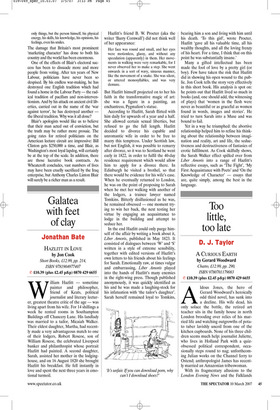Galatea with feet of clay
Jonathan Bate
HAZLITT IN LOVE by Jon Cook Short Books, £12.99, pp. 214, ISBN 9781904977407 ✆ £10.39 (plus £2.45 p&p) 0870 429 6655 William Hazlitt — sometime painter and philosopher, friend of Keats, political journalist and literary lecturer, greatest theatre critic of the age — was living apart from his wife. For 14 shillings a week he rented rooms in Southampton Buildings off Chancery Lane. His landlady was married to a tailor, Micaiah Walker. Their eldest daughter, Martha, had recently made a very advantageous match to one of their lodgers, Robert Roscoe, son of William Roscoe, the celebrated Liverpool banker and philanthropist whose portrait Hazlitt had painted. A second daughter, Sarah, assisted her mother in the lodginghouse, and on 16 August 1820 she brought Hazlitt his breakfast. He fell instantly in love and spent the next three years in emotional turmoil. Hazlitt’s friend B. W. Procter (aka the writer ‘Barry Cornwall’) did not think well of her appearance:
Her face was round and small, and her eyes were motionless, glassy, and without any speculation (apparently) in them. Her movements in walking were very remarkable, for I never observed her to make a step. She went onwards in a sort of wavy, sinuous manner, like the movement of a snake. She was silent, or uttered monosyllables, and was very demure.
But Hazlitt himself projected on to her his faith in the transformative magic of art: she was a figure in a painting, an enchantress, Pygmalion’s statue.
According to Hazlitt, Sarah flirted with him daily for upwards of a year and a half. She allowed certain sexual liberties, but refused to go the full length. Hazlitt decided to divorce his capable and unromantic wife in order to be free to marry this temptress. Under Scottish law, but not English, it was possible to remarry after divorce, so it was to Scotland he went early in 1822, in order to fulfil the 40-day residence requirement which would allow him to apply for a divorce there. In Edinburgh he visited a brothel, so that there would be evidence for his wife’s case. When he eventually returned to London, he was on the point of proposing to Sarah when he met her walking with another of the lodgers, a trainee lawyer named Tomkins. Bitterly disillusioned as he was, he remained obsessed — one moment trying to win her back, the next testing her virtue by engaging an acquaintance to lodge in the building and attempt to seduce her.
In the end Hazlitt could only purge himself of the affair by writing a book about it, Liber Amoris, published in May 1823. It consisted of dialogues between ‘W’ and ‘S’ written in a style of extreme sensibility, together with edited versions of Hazlitt’s own letters to his friends about his feelings for Sarah. Emotionally raw, at times vulgar and embarrassing, Liber Amoris played into the hands of Hazlitt’s many enemies in the right-wing press. Though published anonymously, it was quickly identified as his and he was made a laughing-stock for his infatuation with ‘the tailor’s daughter’. Sarah herself remained loyal to Tomkins, bearing him a son and living with him until his death. ‘To this girl’, wrote Procter, Hazlitt ‘gave all his valuable time, all his wealthy thoughts, and all the loving frenzy of his heart. For a time, I think that on this point he was substantially insane.’ Many a gifted intellectual has been made the fool of love by a pretty girl (or boy). Few have taken the risk that Hazlitt did in showing his open wound to the public. Jon Cook tells the story very effectively in this short book. His analysis is spot on: he points out that Hazlitt lived so much in books (and, one should add, the witnessing of plays) that ‘women in the flesh were never as beautiful or as graceful as women found in words, images and stories’. He tried to turn Sarah into a Muse and was bound to fail.
Yet in a way he triumphed: the abortive relationship helped him to refine his thinking about the relationship between imagination and reality, art and life, the seductiveness and destructiveness of fantasies of erotic fulfilment. As Cook skilfully shows, the Sarah Walker effect spilled over from Liber Amoris into a range of Hazlitt’s reflective essays, such as ‘The Fight’, ‘My First Acquaintance with Poets’ and ‘On the Knowledge of Character’ — essays that are, quite simply, among the best in the language.


























































































 Previous page
Previous page